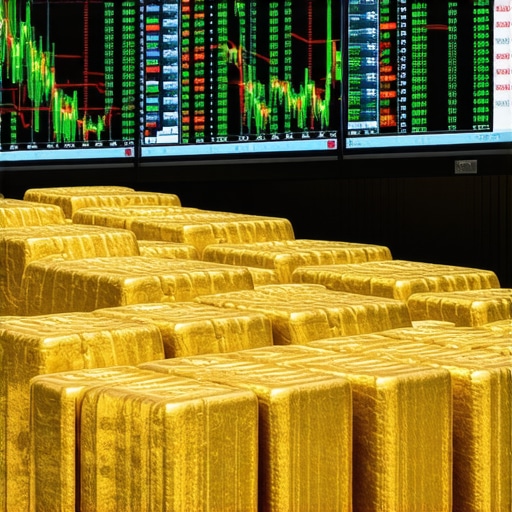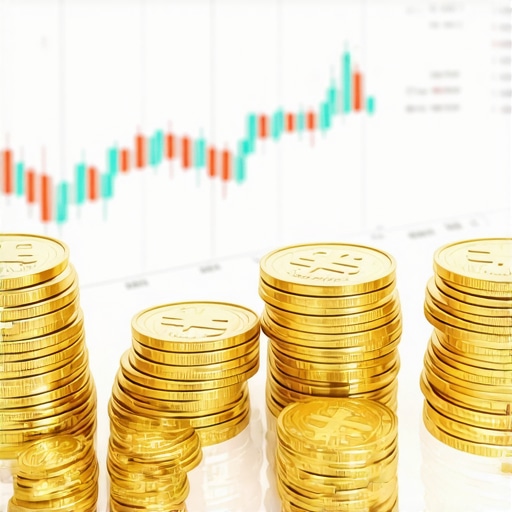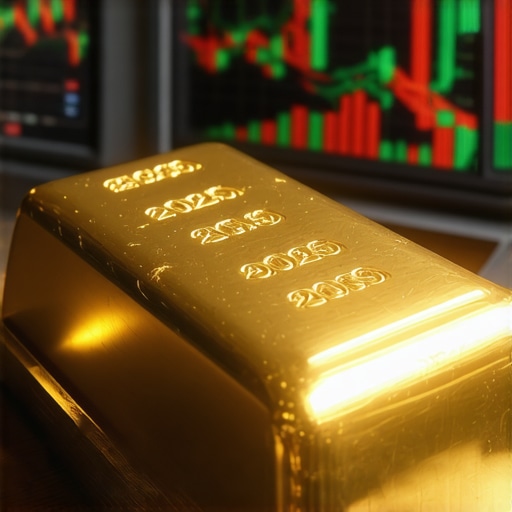Unlocking the Golden Equation: Mastering Supply and Demand in Your Investment Portfolio
In the intricate world of precious metals investing, understanding the dynamic interplay between gold supply and demand is paramount to crafting a resilient and profitable portfolio. Unlike other assets, gold’s value is profoundly influenced by unique global factors that ebb and flow with economic tides, geopolitical shifts, and market sentiment. This guide delves deep into the nuanced mechanics of gold markets, equipping you with expert insights to balance these forces intelligently and optimize your investment strategy.
Decoding Gold Supply: Beyond the Mine
Gold supply is not merely about mining output; it encompasses recycled gold, central bank reserves, and even above-ground stocks. Annual gold mining production is relatively stable, averaging around 3,000 metric tons globally, but it is the interplay with secondary sources such as scrap gold that adds complexity to supply dynamics. For instance, during economic downturns, heightened gold recycling can temporarily increase supply, influencing prices. Recognizing these layers helps investors anticipate shifts that raw production data alone might miss.
Demand Drivers: Cultural, Industrial, and Investment Forces
Gold demand spans several sectors: jewelry, technology, central bank acquisitions, and investment vehicles. Jewelry demand, particularly in emerging markets like India and China, accounts for nearly half of the total demand and is sensitive to cultural trends and economic well-being. Industrial demand, while smaller, remains steady due to gold’s unique conductive properties. Central banks have recently become aggressive buyers, reshaping demand fundamentals significantly. Additionally, investor appetite through ETFs, coins, and bars fluctuates with market volatility and inflation expectations, requiring keen observation.
How Can Investors Effectively Balance Gold Supply and Demand to Optimize Portfolio Performance?
Balancing supply and demand in your portfolio demands vigilance and a multi-pronged strategy. Firstly, monitor global economic indicators, such as inflation rates and currency strength, which directly impact investor demand for gold as a safe haven. Secondly, stay informed about central bank gold purchase trends, as these can signal shifts in global monetary policy and influence market liquidity; for example, understanding central bank gold buying patterns offers critical foresight. Thirdly, diversify your gold holdings across physical bullion, ETFs, and mining stocks to hedge against supply disruptions or demand swings. Lastly, adopt a flexible timeline, adjusting allocations as market signals evolve, rather than adhering rigidly to static targets.
Practical Wisdom: Real-World Application in Portfolio Management
Consider the 2020 market turmoil when central banks accelerated gold purchases amid pandemic uncertainty, driving prices to historic highs. Investors who balanced physical gold with gold mining equities and ETFs capitalized on both price appreciation and dividend yields. Another example is the cyclical surge in jewelry demand during cultural festivals, which can temporarily tighten supply and push prices upward. By integrating such tangible market intelligence, investors transcend passive gold ownership and engage in proactive portfolio stewardship.
Embracing Advanced Analytics: The Future of Gold Demand Forecasting
Cutting-edge forecasting techniques leverage artificial intelligence and big data to analyze complex patterns in gold supply and demand. Tools that synthesize macroeconomic data, geopolitical developments, and social sentiment provide investors with actionable insights. Embracing these innovations can enhance decision-making precision, enabling you to anticipate market shifts before they materialize fully.
If you found these insights valuable, share your thoughts below or explore our detailed gold supply and demand guide for deeper knowledge.
For authoritative perspectives on gold market fundamentals, refer to the World Gold Council’s research reports, which offer comprehensive data and analysis pivotal for any serious investor (World Gold Council Research).
Refining Your Gold Investment Approach with Market Nuances
Reflecting on my journey with gold investing, one lesson stands out vividly: it’s not just about owning gold, but understanding the subtle market rhythms that define its value. For instance, I learned early on that gold’s price often reacts not just to tangible supply changes but also to psychological factors like investor sentiment and geopolitical tensions. When the markets turn jittery, demand for gold as a refuge surges, often outpacing actual supply shifts.
This dynamic means that staying attuned to global developments is crucial. I remember when US inflation numbers spiked unexpectedly; gold prices jumped sharply as investors sought protection. This wasn’t due to a sudden change in mine output but a surge in demand driven by fear of currency devaluation. Being prepared for such moments helped me adjust my portfolio quickly, embracing a mix of physical bullion and gold ETFs that could be traded easily.
Exploring the Role of Technology in Gold Market Analysis
One of the most exciting aspects of modern gold investing is how technology empowers us to decode market signals more efficiently. I recently started using AI-powered analytics platforms that aggregate data from thousands of sources — economic indicators, social media trends, and even satellite imagery of mining activities. This holistic view provides a clearer picture of potential shifts in supply or demand before they become obvious.
For those curious, the World Gold Council offers excellent resources and research that complement these tools, helping investors blend traditional wisdom with innovative forecasting methods. Combining such insights with personal vigilance has transformed my strategy from reactive to proactive.
Gold Investment Vehicles: Which One Fits Your Style Best?
Given the diverse ways to invest in gold, I often get asked: “Which gold investment type suits me best?” From physical gold bars and coins to ETFs, mining stocks, and mutual funds, each has its merits and challenges. Personally, I appreciate holding some physical gold for its tangible security and intrinsic value. However, ETFs provide liquidity and ease of trading, while mining stocks offer growth potential but come with higher risk.
Balancing these options depends on your risk tolerance, investment horizon, and financial goals. For beginners, a well-rounded approach might involve starting with physical gold and a gold ETF to build foundational exposure. More seasoned investors can explore mining stocks or mutual funds for diversification and potential upside.
How do you decide which gold investment vehicle aligns best with your financial goals and comfort level?
I’d love to hear your experiences or dilemmas on choosing among gold investment types—do you prefer the security of physical gold or the flexibility of ETFs and stocks? Share your thoughts in the comments!
If you’re keen to dive deeper into different gold investment options, check out this comprehensive guide on choosing the right gold investment vehicle that breaks down the nuances in a friendly, accessible way.
Unraveling Gold Market Volatility: Strategies for Sophisticated Investors
Gold’s historical role as a safe haven asset often masks the intricate volatility patterns that sophisticated investors must navigate. Unlike traditional equities or bonds, gold’s price dynamics are influenced by a unique set of factors including geopolitical tensions, monetary policy shifts, and speculative flows, which can trigger rapid price swings. Understanding these drivers at an advanced level empowers investors to anticipate fluctuations and leverage volatility rather than merely endure it.
For instance, geopolitical crises often induce a flight to gold, pushing demand sharply upward even if physical supply remains unchanged. Conversely, periods of aggressive monetary tightening can dampen gold’s appeal, causing swift corrections. Successfully navigating these waters requires integrating macroeconomic analysis with real-time market sentiment data and positioning accordingly.
Advanced Hedging Techniques: Leveraging Derivatives to Manage Gold Exposure
Beyond physical holdings and ETFs, derivatives such as futures, options, and structured products offer sophisticated tools for hedging and enhancing portfolio performance. Futures contracts allow investors to lock in prices, mitigating downside risk during uncertain periods. Options provide asymmetric risk profiles, enabling strategic plays on gold’s directional moves without full exposure.
Implementing these instruments effectively demands expertise in contract specifications, margin requirements, and timing. For example, during periods of anticipated volatility, purchasing gold call options can offer leveraged upside potential with limited risk, while protective puts can safeguard existing holdings against sharp downturns.
What Are the Key Considerations When Incorporating Gold Derivatives into a Diversified Portfolio?
When integrating derivatives, investors must carefully assess liquidity, counterparty risk, and alignment with overall investment objectives. It’s crucial to maintain transparency on the costs involved, including premiums and margin calls, which can impact returns. Moreover, derivatives require active management and disciplined exit strategies to avoid unintended exposures.
According to the CME Group’s educational resources on gold futures and options, understanding contract nuances and market behavior is foundational to harnessing these tools effectively.
Integrating Behavioral Economics: Decoding Investor Sentiment in Gold Markets
Beyond quantitative data, behavioral economics offers profound insights into gold price movements. Investor sentiment, herd behavior, and cognitive biases often amplify price trends, creating opportunities and risks that pure fundamentals may not predict. Monitoring sentiment indices, social media analytics, and trading volumes can reveal emerging narratives before they fully impact prices.
For example, during rapid market sell-offs, irrational panic can lead to temporary undervaluation of gold, presenting buying opportunities for contrarian investors. Conversely, euphoric buying driven by fear of inflation may inflate prices beyond intrinsic value, signaling caution.
Harnessing Blockchain and Tokenization: The Next Frontier in Gold Investment
The advent of blockchain technology introduces innovative pathways for gold investment through tokenization. By representing physical gold ownership digitally, tokenized gold offers enhanced liquidity, transparency, and fractional ownership possibilities. This democratizes access to gold markets and enables seamless trading across borders.
However, tokenization also presents challenges including regulatory scrutiny, custodial risks, and the need for robust verification mechanisms to ensure the authenticity of underlying assets. Investors exploring this frontier should conduct thorough due diligence and consider integrating tokenized assets as part of a broader, diversified gold strategy.
Positioning for the Future: Anticipating Gold’s Role in a Changing Financial Ecosystem
As global economic paradigms evolve, gold’s role is likely to adapt alongside emerging monetary technologies and shifting geopolitical alliances. Central banks’ strategic reserves management, the rise of digital currencies, and inflationary pressures will continue to redefine gold’s investment thesis.
Staying ahead requires continuous learning and agility. Engage with expert communities, leverage cutting-edge analytics, and refine your approach dynamically to maintain a competitive edge in gold investing.
If you’re ready to deepen your expertise and master complex gold market strategies, explore our advanced resources and join the discussion with fellow expert investors.
Deciphering Macro Trends: How Global Policy Shifts Reshape Gold Demand
Gold’s intricate relationship with global monetary policy underscores its sensitivity to central bank actions and fiscal stimuli. When major economies embark on quantitative easing or adjust interest rates, gold demand often reacts preemptively. Understanding these macroeconomic levers enables investors to anticipate demand fluctuations beyond surface-level market data.
For instance, the Federal Reserve’s signaling on rate hikes can precipitate rapid gold price adjustments as investors recalibrate inflation expectations and currency valuations. This interplay demands a nuanced grasp of cross-border capital flows and their influence on gold’s appeal as a hedge.
What advanced analytical frameworks best predict gold demand shifts amid evolving global monetary policies?
Expert investors increasingly leverage multi-factor econometric models integrating interest rate trajectories, inflation forecasts, and geopolitical risk indices to forecast gold demand with greater precision. Combining these quantitative tools with sentiment analysis from financial news feeds and central bank communications creates a comprehensive predictive apparatus.
Such methodologies are elaborated in the World Gold Council’s Gold Demand Trends reports, which synthesize macroeconomic data and market intelligence to guide sophisticated investment decisions.
Synergizing Physical and Digital Gold: Navigating Tokenization and Custodial Innovations
The burgeoning field of gold tokenization offers a compelling complement to traditional physical holdings, marrying blockchain transparency with gold’s intrinsic value. However, integrating tokenized gold alongside bullion requires meticulous evaluation of custodial integrity, regulatory frameworks, and liquidity profiles.
Investors must scrutinize smart contract reliability, provenance verification mechanisms, and interoperability with existing portfolio infrastructures. This hybrid approach can unlock new avenues for fractional ownership and instantaneous settlement, enhancing portfolio agility.
Applying Quantitative Hedging Models: Mitigating Gold Price Volatility with Derivatives
Advanced investors employ stochastic volatility models and Monte Carlo simulations to optimize derivative hedging strategies, calibrating option strike prices and maturities to market conditions. This precision hedging attenuates downside risks while preserving upside participation.
Furthermore, dynamic delta-hedging techniques allow real-time adjustment of exposure in response to shifting market parameters, a practice widely endorsed by professional traders managing gold futures and options.
Integrating Behavioral Signals: Leveraging Sentiment Analytics for Tactical Positioning
Behavioral finance insights reveal that gold markets are often swayed by collective investor psychology, where fear and greed cycles amplify price volatility. Harnessing sentiment analytics tools that parse social media chatter, news sentiment, and trading volume anomalies can provide early warnings of market inflection points.
For example, sudden spikes in bearish sentiment amidst stable fundamentals may signal oversold conditions ripe for tactical accumulation.
Charting the Future: Gold’s Strategic Role Amid Digital Currency Proliferation
As central banks explore digital currencies and decentralized finance evolves, gold’s role as a monetary anchor faces both challenges and reinvention opportunities. While digital assets introduce alternative stores of value, gold’s unparalleled liquidity and historical trust maintain its foundational status.
Strategic investors should monitor interoperability developments between tokenized gold and digital currency platforms, positioning to capitalize on converging financial ecosystems.
If you seek to elevate your gold investment acumen and harness these advanced insights, join our community of expert investors and access exclusive analytical tools tailored for nuanced market navigation.
Frequently Asked Questions (FAQ)
What factors most significantly influence gold supply beyond mining production?
Gold supply extends beyond mining output to include recycled gold, central bank reserves, and above-ground stocks. Economic downturns often increase gold recycling, temporarily boosting supply. Additionally, central bank sales or acquisitions can shift available gold volumes, impacting market balance. Understanding these multifaceted sources provides a fuller picture of supply dynamics.
How do cultural and economic trends in emerging markets affect gold demand?
Emerging markets like India and China dominate jewelry demand, which is culturally driven and sensitive to economic growth and consumer confidence. Festivals and weddings trigger seasonal demand surges, tightening supply and elevating prices temporarily. Investors monitoring these trends can anticipate cyclical shifts in demand, refining timing and allocation strategies.
Why is it important to diversify gold investment vehicles within a portfolio?
Diversification across physical gold, ETFs, and mining stocks balances liquidity, risk, and return profiles. Physical gold offers tangible security; ETFs provide tradability and cost efficiency; mining equities deliver growth potential but with higher volatility. Combining these instruments helps manage supply disruptions and demand fluctuations, optimizing portfolio resilience.
How can advanced analytics improve forecasting of gold demand?
Artificial intelligence and big data platforms integrate macroeconomic indicators, geopolitical events, and investor sentiment to detect complex patterns influencing gold demand. These tools enhance precision in predicting market shifts, allowing investors to position proactively rather than reactively.
What role do derivatives play in managing gold investment risk?
Gold derivatives such as futures and options provide mechanisms for hedging against price volatility and crafting strategic exposure. Futures lock in prices, reducing downside risk, while options offer asymmetric risk profiles for leveraged opportunities or downside protection. Effective use demands understanding contract details, costs, and active management.
How does investor sentiment impact gold price movements?
Behavioral factors like fear, greed, and herd behavior often amplify gold volatility beyond fundamental supply and demand changes. Sentiment analytics—tracking social media, news flows, and trading volumes—can reveal early signals of market turning points, enabling tactical positioning to exploit mispricings.
What are the challenges and benefits of gold tokenization?
Tokenized gold leverages blockchain to enable fractional ownership, increased liquidity, and seamless cross-border trading. However, it raises concerns about regulatory compliance, custodial trust, and asset verification. Integrating tokenized gold requires rigorous due diligence and thoughtful portfolio integration to realize benefits safely.
How do macroeconomic policies influence gold demand?
Monetary policy decisions—such as interest rate adjustments and quantitative easing—alter inflation expectations and currency valuations, directly impacting gold’s attractiveness as a hedge. Sophisticated models combining econometrics and sentiment data help forecast demand fluctuations tied to policy shifts.
What strategies can investors use to navigate gold market volatility?
Successful navigation involves combining macroeconomic analysis, sentiment monitoring, and flexible allocation among gold instruments. Employing derivative hedging, diversifying holdings, and maintaining agility to respond to geopolitical events or policy changes can turn volatility into opportunity.
How might digital currency developments affect gold’s investment role?
As digital currencies evolve, gold remains a foundational store of value due to its liquidity and historical trust. Interoperability between tokenized gold and digital currency platforms could create synergistic investment opportunities, but investors must stay informed on technological and regulatory landscapes to position advantageously.
Trusted External Sources
- World Gold Council (WGC) – Offers comprehensive research and data on gold supply-demand dynamics, investor trends, and macroeconomic influences, providing authoritative market intelligence essential for informed decision-making (Gold Hub Research).
- CME Group – Provides detailed educational resources and market data on gold futures and options, critical for understanding derivative instruments and advanced hedging strategies (CME Gold Futures & Options Education).
- International Monetary Fund (IMF) – Tracks central bank gold reserves and global monetary policy trends that shape gold market fundamentals, offering macroeconomic context vital to forecasting demand shifts (IMF Data).
- Bloomberg Terminal – Delivers real-time market data, sentiment analytics, and geopolitical news essential for advanced investors seeking to integrate behavioral economics and timely insights into gold market strategies.
- MIT Sloan School of Management – Behavioral Economics Research – Provides academic and applied insights on investor psychology and market sentiment effects relevant to gold pricing and volatility patterns.
Conclusion
Mastering the complexities of gold supply and demand is indispensable for crafting a sophisticated investment portfolio that withstands volatility and capitalizes on market opportunities. This article illuminated how multifaceted supply sources, diverse demand drivers, and cutting-edge analytics converge to shape gold’s price dynamics. By diversifying investment vehicles, integrating behavioral and macroeconomic insights, and employing advanced hedging and tokenization strategies, investors can navigate gold markets with precision and confidence. Embracing this nuanced approach elevates gold investing from mere ownership to strategic stewardship, enhancing portfolio resilience in an evolving financial landscape.
We invite you to share your experiences, pose questions, and explore our expert resources to deepen your knowledge. Harness these insights to refine your gold investment journey and stay ahead in the dynamic world of precious metals.










